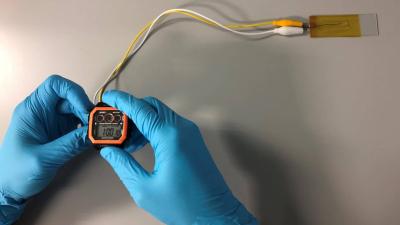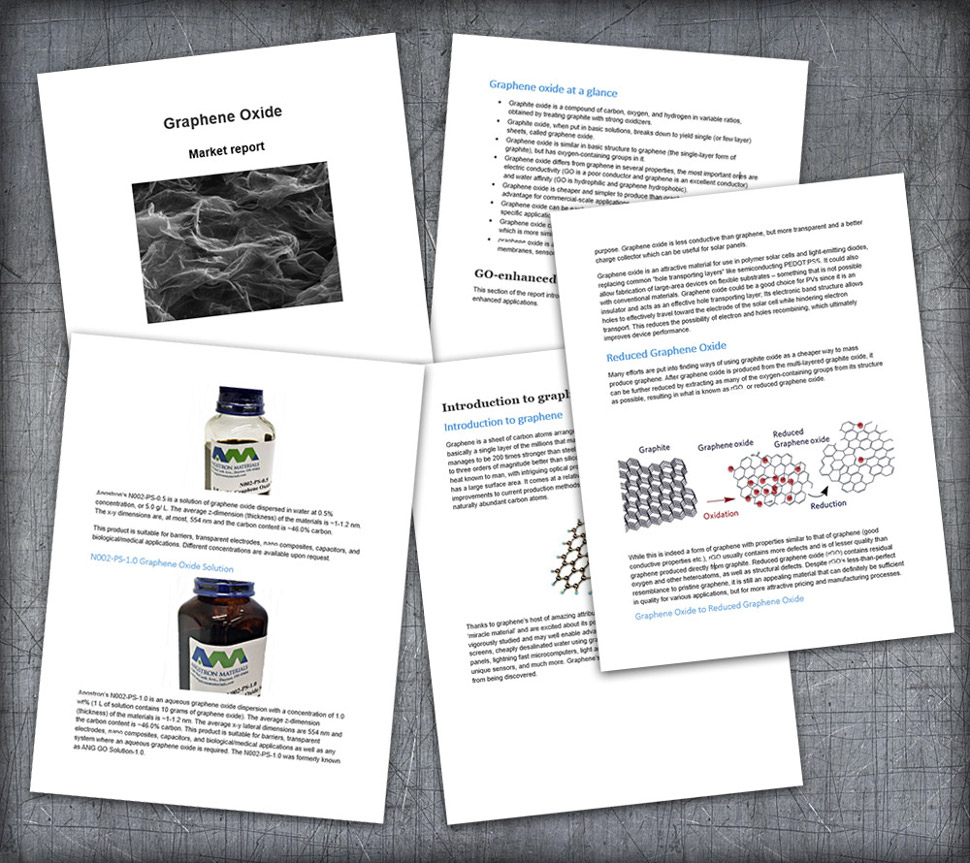Graphene Oxide: Introduction and Market News - Page 4
Researchers develop graphene-based cathode in the shape of a thread-like fiber
Researchers at North Carolina State University (NC State), National Science and Technology Development Agency and NSTDA Characterization and Testing Service Center in Thailand have created a graphene-based cathode in the shape of a thread-like fiber. The researchers were then able to use the fiber to create a zinc-ion battery prototype that could power a wrist watch.
Battery prototype with thread-like cathode. Image from NCSU website
The proof-of-concept study is a step forward in the development of a fiber-shaped battery that could ultimately be integrated into garments.
Researchers create graphene hydrogels for efficient water purification
A team of researchers, led by Professor Aravind Vijayaraghavan based in the National Graphene Institute (NGI), have produced 3D particles made of graphene that come in various interesting shapes, using a variation of the vortex ring effect. These particles have also been shown to be exceptionally efficient in adsorbing contaminants from water, thereby purifying it.
Optical and SEM images of donut, spherical and jellyfish morphologies of GO-VR
The researchers have shown that the formation of these graphene particles is governed by a complex interplay between different forces such as viscosity, surface tension, inertia and electrostatics. Prof Vijayaraghavan said: “We have undertaken a systematic study to understand and explain the influence of various parameters and forces involved in the particle formation. Then, by tailoring this process, we have developed very efficient particles for adsorptive purification of contaminants from water”.
A new version of our Graphene Oxide Market report released
Today we published a new edition of our Graphene Oxide Market Report, with all the latest information, including both new research activities and updates from companies. Our market report is a comprehensive guide to graphene oxide (and r-GO) materials and their promising applications in energy storage, composite materials, bio-medical, water treatment and more.
Reading this report, you'll learn all about:
- The difference between graphene oxide and graphene
- Graphene oxide properties
- Possible applications for graphene oxide
- Reduction of graphene oxide to r-GO
The report package also provides:
- A list of prominent GO research activities
- A list of all graphene oxide developers and their products
- Datasheets for over 20 different GO materials
- Free updates for a year
This Graphene Oxide market report provides a great introduction to graphene oxide materials and applications, and covers everything you need to know about GO materials on the market. This is a great guide for anyone interested in applying graphene oxide in their products.
Researchers develop improved method for producing graphene-based gas sensors
Researchers from Penn State and University of Electronic Science and Technology of China recently enhanced their gas sensor manufacturing process through an in situ laser-assisted manufacturing approach, improving on their previous method of drop casting (dropping materials one by one onto a substrate using a pipette.
Flexible gas sensors can be used as medical devices to identify health conditions by detecting oxygen or carbon dioxide levels in the breath or sweat. They are also useful for monitoring air quality in indoor or outdoor environments by detecting gas, biomolecules and chemicals.
Researchers discover how "explosive percolation" turns GO paint extremely conductive
University of Sussex scientists, along with teams from Spain's Instituto de Carboquímica (ICB-CSIC) and Instituto de Nanociencia de Aragon (INA), UK's University of Brighton, France's Institut des Materiaux Nantes Jean Rouxel and Rice University in the U.S, have demonstrated how a conductive paint coating that they have developed mimics the network spread of a virus through a process called 'explosive percolation'—a mathematical process which can also be applied to population growth, financial systems and computer networks, but which has not been seen before in materials systems.
The process of percolation—the statistical connectivity in a system, such as when water flows through soil or through coffee grounds—is an important component in the development of liquid technology. And it was that process which the research group was expecting to see when they added graphene oxide to polymer latex spheres, such as those used in emulsion paint, to make a polymer composite. However, when the team heated the graphene oxide to make it electrically conductive, the scientists kick-started a process that saw this conductive system grow exponentially, to the extent that the new material created consumed the network, similar to the way a new strain of a virus can become dominant.
Researchers examine the influence of graphene oxide on gut microbiome and the immune system
Researchers from the Karolinska Institute in Sweden and the Catalan Institute of Nanoscience and Nanotechnology (ICN2) in Spain have found that oral exposure to graphene oxide (GO) modulates the composition of the gut microbiome in adult zebrafish and can influence the crosstalk between the microbiome and immune system.
"This shows that we must factor the gut microbiome into our understanding of how nanomaterials affect the immune system," said the paper's corresponding author Bengt Fadeel, professor at the Institute of Environmental Medicine, Karolinska Institutet. "Our results are important for identifying the potential adverse effects of nanomaterial and mitigating or preventing such effects in new materials."
Graphene oxide could help harvest ocean osmotic energy
Researchers from Deakin University's Institute for Frontier Materials (IFM) aim to harness the ocean's potential for renewable and clean energy. In a recent study, they demonstrated how a two-dimensional (2D) nanomaterial membrane technology can improve blue energy harvesting processes. Blue energy harvesting is renewable energy that uses the salt content difference between river water and seawater to generate electricity.
"Ocean energy is made up of five forms—tidal, water waves, ocean currents, temperature gradients and salinity gradient energy, offering a potential alternative, limitless energy resource," says Associate Professor Weiwei Lei, who is leading the sustainable energy generation project at IFM. "Therefore, harvesting ocean energy through artificial devices has attracted tremendous interest. In particular, salinity gradient energy, also called 'osmotic energy' or 'blue energy,' provides significant promise for the development of renewable energy. It has a potential 1 TW energy (8500 TW h in a year), which exceeds the sum of hydraulic, nuclear, wind and solar energy in 2015. With the development of nanotechnology and 2D nanomaterials, novel 2D nanomaterials' membranes with nanopores and nanochannels were designed for blue energy harvesting. However, the energy harvesting efficiency of these membranes is still too low to meet the demands of practical applications due to their high internal resistance and low selectivity of ions. New advanced 2D nanomaterial membranes with novel and robust properties will solve this problem, which is in high demand now."
Researchers achieve water-enabled electricity generation through highly oriented graphene oxide nanochannels
Researchers from China's Tsinghua University have constructed highly aligned graphene oxide (GO) nanochannels for sustainable energy production using a freeze-casting process. The new method could address an issue that impedes the generation of electricity from natural water flow through engineered nanochannels, which could become a viable way to cater to the fast-growing renewable power needs.
Large-scale nanochannel integration and the multi-parameter coupling restrictive influence on electric generation currently remain big challenges for macroscale applications, but this novel design encourages spontaneous absorption and directed transfer of water within the nanochannels to generate clean electricity.
Researchers use graphene oxide to create a self-powered sensor that translates sign language into audio
Researchers from Tsinghua University recently developed a self-powered sensor that can monitor and detect multiple environmental stimuli simultaneously and demonstrated how it can “translate” sign language into audio.
The sensor was made from graphene oxide and powered internally by a moist electric generator called MEG, which contains a membrane that spontaneously absorbs water from the air. When water adheres to the surface, this results in a higher concentration of hydrogen ions at the top of the membrane and a potential difference between its two electrodes.
Graphene Composites and William Blythe announce supply of graphene oxide for ink coating that destroys pathogens
Graphene Composites (GC) and William Blythe have announced a partnership in William Blythe’s supply of graphene oxide for use in GC Halo, a unique coating for air filters that destroys viruses, bacteria and mold on contact.
GC Halo is a nanoparticle ink formulation, that destroys pathogens by forming a ‘trap and kill’ layer on air filters and has been independently verified to significantly reduce SARS-CoV-2 coronavirus in the air. Fast-acting, safe and more than 99% effective against SARS-CoV-2 coronavirus, Influenza, bacteria and mold, independent tests and certifications reportedly prove GC Halo’s capabilities as a filter coating.
Pagination
- Previous page
- Page 4
- Next page










